Implementation of Equality and Diversity Practices at Tesco Workplace
VerifiedAdded on 2023/01/11
|13
|2437
|61
Report
AI Summary
This research proposal investigates the significance of implementing equality and diversity practices to eliminate workplace discrimination, using Tesco as a case study. The study aims to understand workplace discrimination, identify effective equality and diversity practices, and determine the benefits of eliminating discrimination within the organization. The research explores the concept and importance of workplace discrimination, various equality and diversity practices, and the advantages gained by management. The methodology includes qualitative and quantitative approaches, primary and secondary data collection methods, and random sampling. The proposal outlines activities, timelines, and ethical considerations, including informed consent and data security. The research will analyze literature, conduct data collection through questionnaires, and present findings to contribute to a better understanding of workplace practices.

Research Proposal
Paraphrase This Document
Need a fresh take? Get an instant paraphrase of this document with our AI Paraphraser
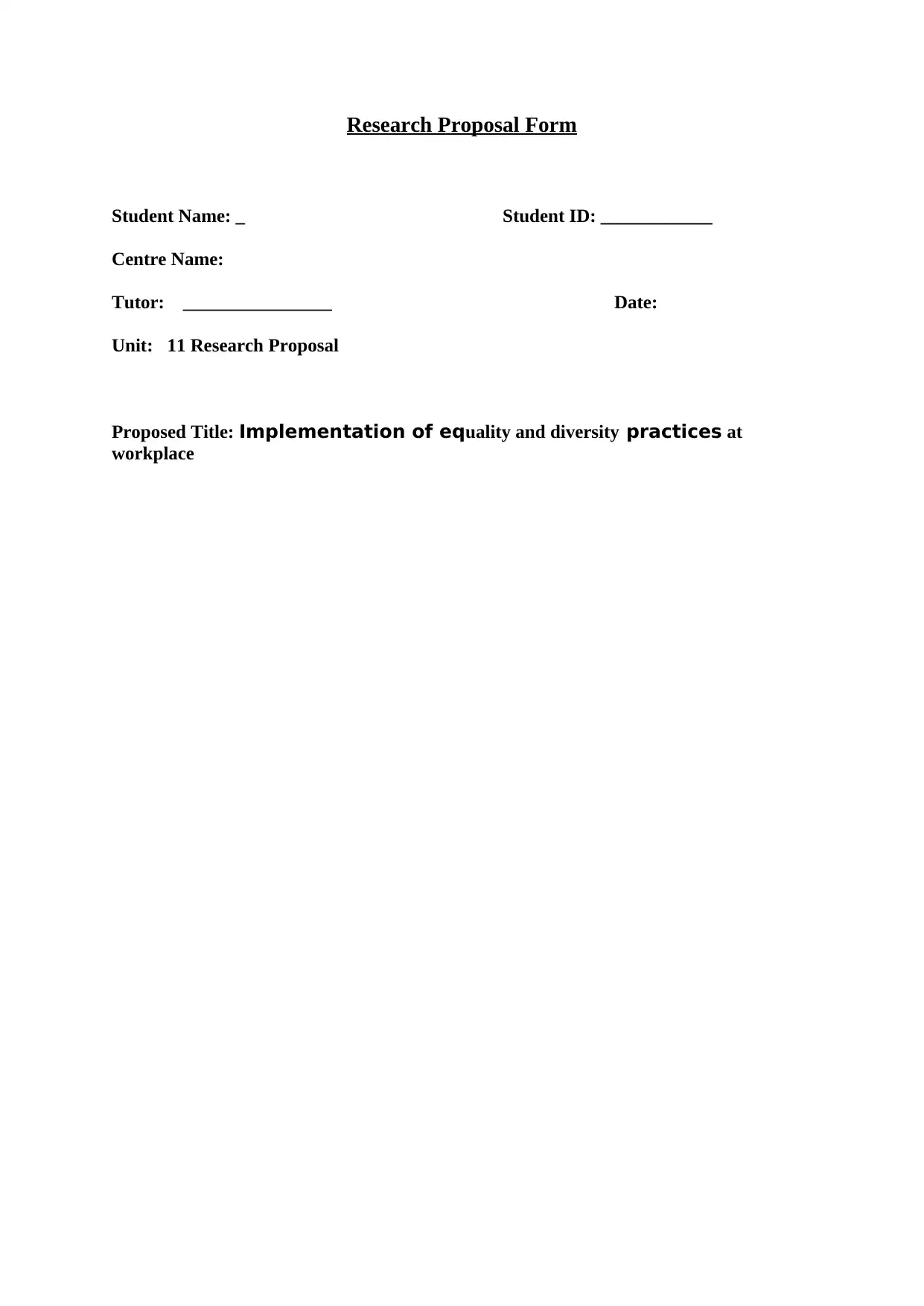
Research Proposal Form
Student Name: _ Student ID: ____________
Centre Name:
Tutor: ________________ Date:
Unit: 11 Research Proposal
Proposed Title: Implementation of equality and diversity practices at
workplace
Student Name: _ Student ID: ____________
Centre Name:
Tutor: ________________ Date:
Unit: 11 Research Proposal
Proposed Title: Implementation of equality and diversity practices at
workplace
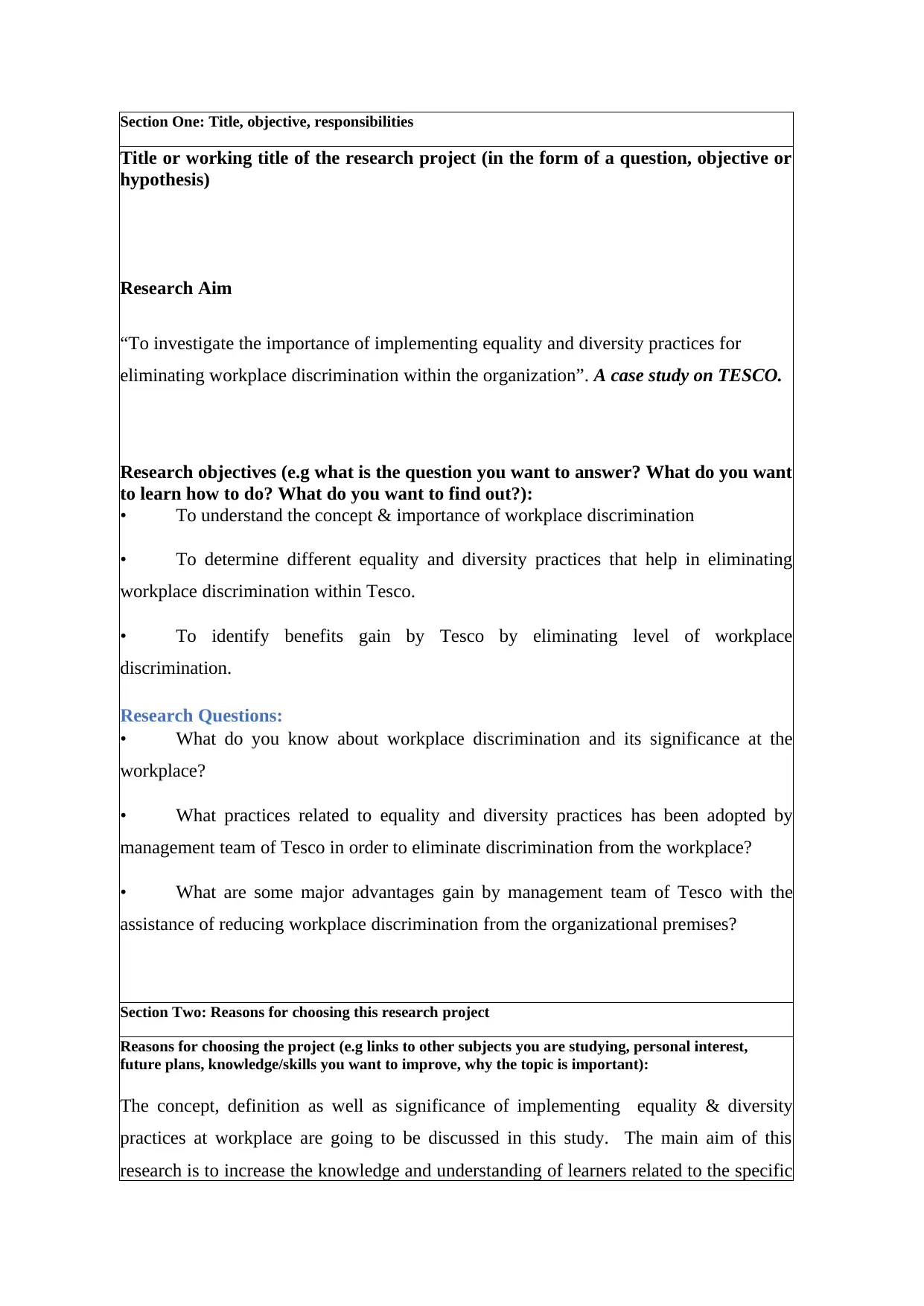
Section One: Title, objective, responsibilities
Title or working title of the research project (in the form of a question, objective or
hypothesis)
Research Aim
“To investigate the importance of implementing equality and diversity practices for
eliminating workplace discrimination within the organization”. A case study on TESCO.
Research objectives (e.g what is the question you want to answer? What do you want
to learn how to do? What do you want to find out?):
• To understand the concept & importance of workplace discrimination
• To determine different equality and diversity practices that help in eliminating
workplace discrimination within Tesco.
• To identify benefits gain by Tesco by eliminating level of workplace
discrimination.
Research Questions:
• What do you know about workplace discrimination and its significance at the
workplace?
• What practices related to equality and diversity practices has been adopted by
management team of Tesco in order to eliminate discrimination from the workplace?
• What are some major advantages gain by management team of Tesco with the
assistance of reducing workplace discrimination from the organizational premises?
Section Two: Reasons for choosing this research project
Reasons for choosing the project (e.g links to other subjects you are studying, personal interest,
future plans, knowledge/skills you want to improve, why the topic is important):
The concept, definition as well as significance of implementing equality & diversity
practices at workplace are going to be discussed in this study. The main aim of this
research is to increase the knowledge and understanding of learners related to the specific
Title or working title of the research project (in the form of a question, objective or
hypothesis)
Research Aim
“To investigate the importance of implementing equality and diversity practices for
eliminating workplace discrimination within the organization”. A case study on TESCO.
Research objectives (e.g what is the question you want to answer? What do you want
to learn how to do? What do you want to find out?):
• To understand the concept & importance of workplace discrimination
• To determine different equality and diversity practices that help in eliminating
workplace discrimination within Tesco.
• To identify benefits gain by Tesco by eliminating level of workplace
discrimination.
Research Questions:
• What do you know about workplace discrimination and its significance at the
workplace?
• What practices related to equality and diversity practices has been adopted by
management team of Tesco in order to eliminate discrimination from the workplace?
• What are some major advantages gain by management team of Tesco with the
assistance of reducing workplace discrimination from the organizational premises?
Section Two: Reasons for choosing this research project
Reasons for choosing the project (e.g links to other subjects you are studying, personal interest,
future plans, knowledge/skills you want to improve, why the topic is important):
The concept, definition as well as significance of implementing equality & diversity
practices at workplace are going to be discussed in this study. The main aim of this
research is to increase the knowledge and understanding of learners related to the specific
⊘ This is a preview!⊘
Do you want full access?
Subscribe today to unlock all pages.

Trusted by 1+ million students worldwide
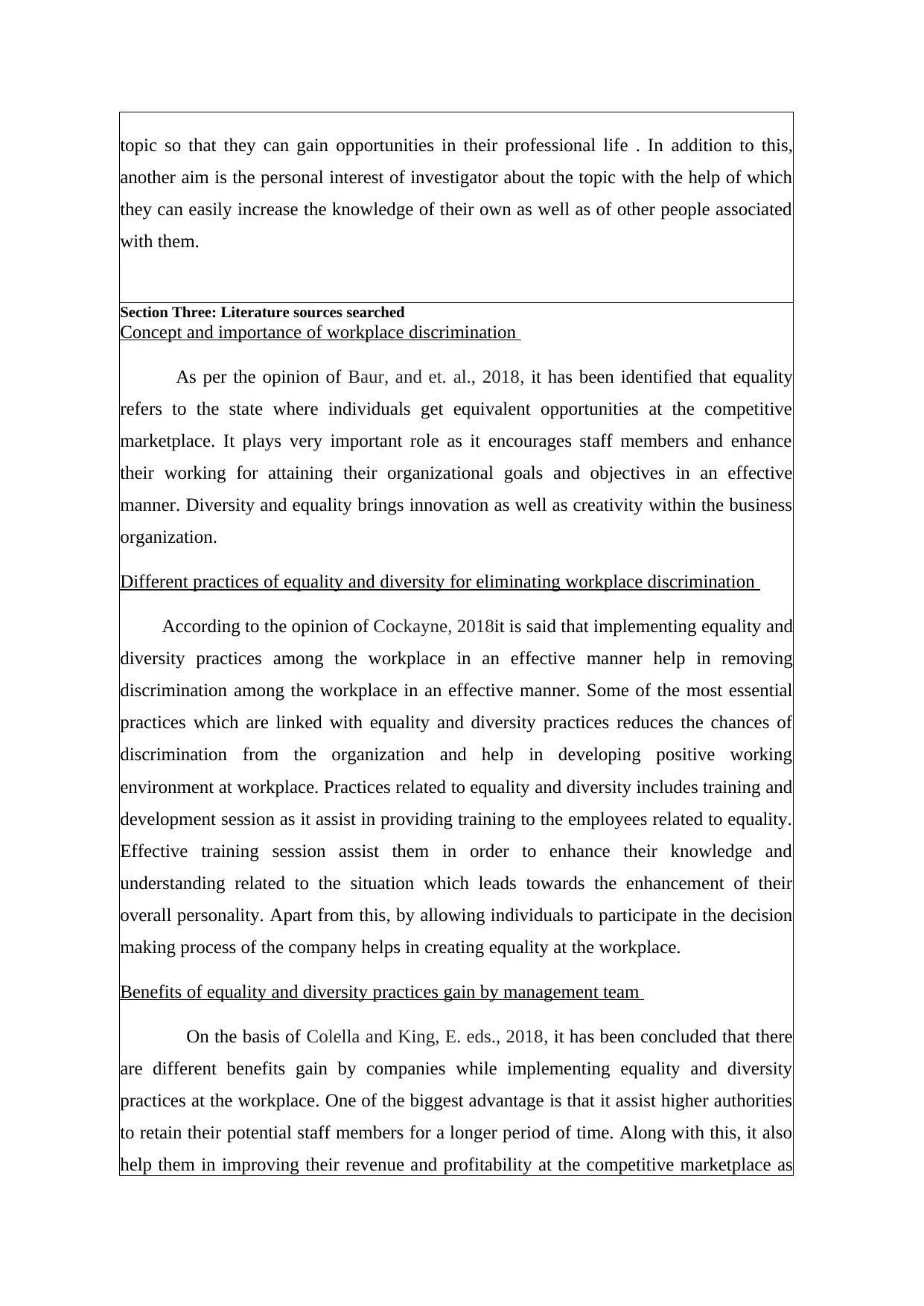
topic so that they can gain opportunities in their professional life . In addition to this,
another aim is the personal interest of investigator about the topic with the help of which
they can easily increase the knowledge of their own as well as of other people associated
with them.
Section Three: Literature sources searched
Concept and importance of workplace discrimination
As per the opinion of Baur, and et. al., 2018, it has been identified that equality
refers to the state where individuals get equivalent opportunities at the competitive
marketplace. It plays very important role as it encourages staff members and enhance
their working for attaining their organizational goals and objectives in an effective
manner. Diversity and equality brings innovation as well as creativity within the business
organization.
Different practices of equality and diversity for eliminating workplace discrimination
According to the opinion of Cockayne, 2018it is said that implementing equality and
diversity practices among the workplace in an effective manner help in removing
discrimination among the workplace in an effective manner. Some of the most essential
practices which are linked with equality and diversity practices reduces the chances of
discrimination from the organization and help in developing positive working
environment at workplace. Practices related to equality and diversity includes training and
development session as it assist in providing training to the employees related to equality.
Effective training session assist them in order to enhance their knowledge and
understanding related to the situation which leads towards the enhancement of their
overall personality. Apart from this, by allowing individuals to participate in the decision
making process of the company helps in creating equality at the workplace.
Benefits of equality and diversity practices gain by management team
On the basis of Colella and King, E. eds., 2018, it has been concluded that there
are different benefits gain by companies while implementing equality and diversity
practices at the workplace. One of the biggest advantage is that it assist higher authorities
to retain their potential staff members for a longer period of time. Along with this, it also
help them in improving their revenue and profitability at the competitive marketplace as
another aim is the personal interest of investigator about the topic with the help of which
they can easily increase the knowledge of their own as well as of other people associated
with them.
Section Three: Literature sources searched
Concept and importance of workplace discrimination
As per the opinion of Baur, and et. al., 2018, it has been identified that equality
refers to the state where individuals get equivalent opportunities at the competitive
marketplace. It plays very important role as it encourages staff members and enhance
their working for attaining their organizational goals and objectives in an effective
manner. Diversity and equality brings innovation as well as creativity within the business
organization.
Different practices of equality and diversity for eliminating workplace discrimination
According to the opinion of Cockayne, 2018it is said that implementing equality and
diversity practices among the workplace in an effective manner help in removing
discrimination among the workplace in an effective manner. Some of the most essential
practices which are linked with equality and diversity practices reduces the chances of
discrimination from the organization and help in developing positive working
environment at workplace. Practices related to equality and diversity includes training and
development session as it assist in providing training to the employees related to equality.
Effective training session assist them in order to enhance their knowledge and
understanding related to the situation which leads towards the enhancement of their
overall personality. Apart from this, by allowing individuals to participate in the decision
making process of the company helps in creating equality at the workplace.
Benefits of equality and diversity practices gain by management team
On the basis of Colella and King, E. eds., 2018, it has been concluded that there
are different benefits gain by companies while implementing equality and diversity
practices at the workplace. One of the biggest advantage is that it assist higher authorities
to retain their potential staff members for a longer period of time. Along with this, it also
help them in improving their revenue and profitability at the competitive marketplace as
Paraphrase This Document
Need a fresh take? Get an instant paraphrase of this document with our AI Paraphraser
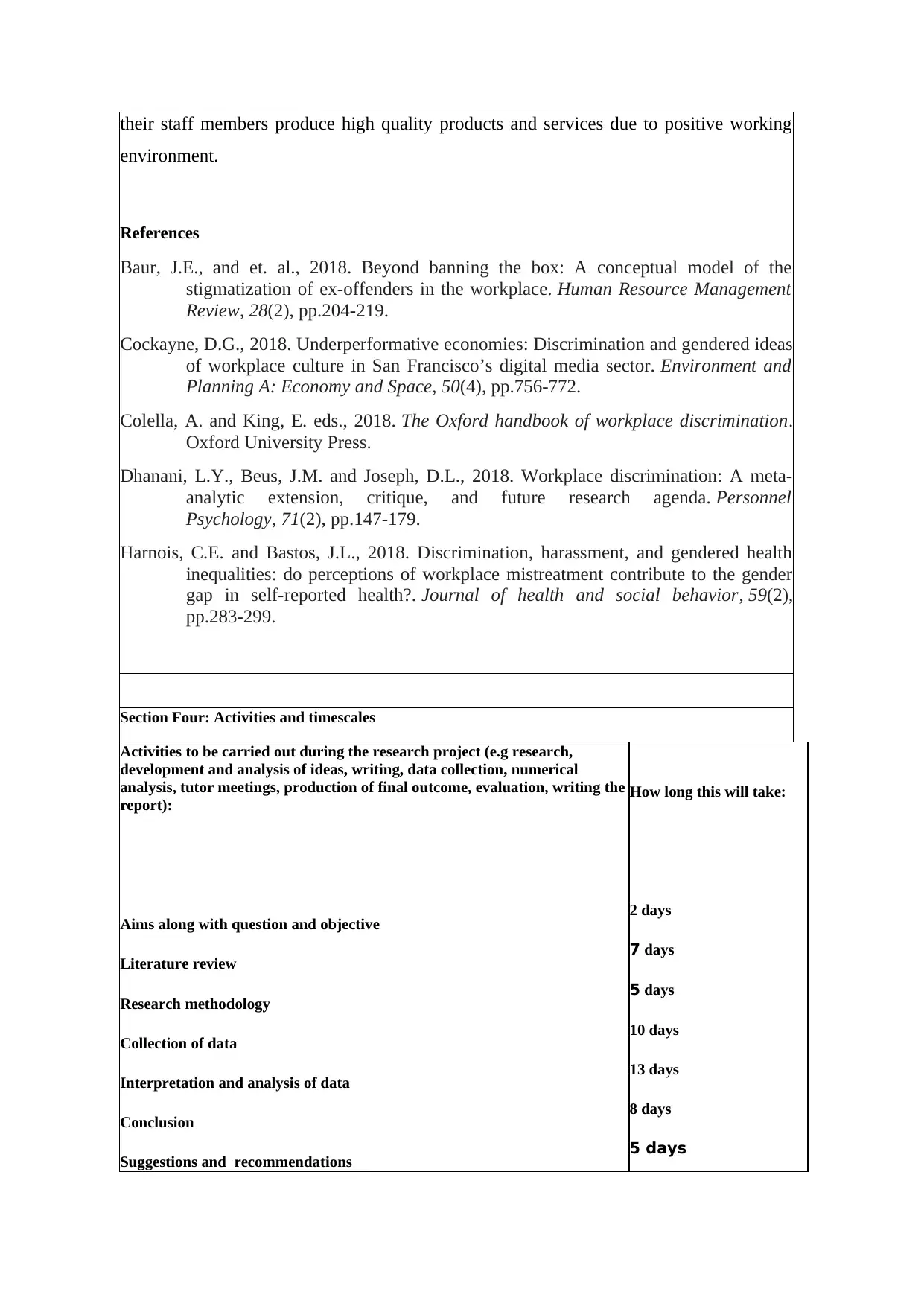
their staff members produce high quality products and services due to positive working
environment.
References
Baur, J.E., and et. al., 2018. Beyond banning the box: A conceptual model of the
stigmatization of ex-offenders in the workplace. Human Resource Management
Review, 28(2), pp.204-219.
Cockayne, D.G., 2018. Underperformative economies: Discrimination and gendered ideas
of workplace culture in San Francisco’s digital media sector. Environment and
Planning A: Economy and Space, 50(4), pp.756-772.
Colella, A. and King, E. eds., 2018. The Oxford handbook of workplace discrimination.
Oxford University Press.
Dhanani, L.Y., Beus, J.M. and Joseph, D.L., 2018. Workplace discrimination: A meta‐
analytic extension, critique, and future research agenda. Personnel
Psychology, 71(2), pp.147-179.
Harnois, C.E. and Bastos, J.L., 2018. Discrimination, harassment, and gendered health
inequalities: do perceptions of workplace mistreatment contribute to the gender
gap in self-reported health?. Journal of health and social behavior, 59(2),
pp.283-299.
Section Four: Activities and timescales
Activities to be carried out during the research project (e.g research,
development and analysis of ideas, writing, data collection, numerical
analysis, tutor meetings, production of final outcome, evaluation, writing the
report):
Aims along with question and objective
Literature review
Research methodology
Collection of data
Interpretation and analysis of data
Conclusion
Suggestions and recommendations
How long this will take:
2 days
7 days
5 days
10 days
13 days
8 days
5 days
environment.
References
Baur, J.E., and et. al., 2018. Beyond banning the box: A conceptual model of the
stigmatization of ex-offenders in the workplace. Human Resource Management
Review, 28(2), pp.204-219.
Cockayne, D.G., 2018. Underperformative economies: Discrimination and gendered ideas
of workplace culture in San Francisco’s digital media sector. Environment and
Planning A: Economy and Space, 50(4), pp.756-772.
Colella, A. and King, E. eds., 2018. The Oxford handbook of workplace discrimination.
Oxford University Press.
Dhanani, L.Y., Beus, J.M. and Joseph, D.L., 2018. Workplace discrimination: A meta‐
analytic extension, critique, and future research agenda. Personnel
Psychology, 71(2), pp.147-179.
Harnois, C.E. and Bastos, J.L., 2018. Discrimination, harassment, and gendered health
inequalities: do perceptions of workplace mistreatment contribute to the gender
gap in self-reported health?. Journal of health and social behavior, 59(2),
pp.283-299.
Section Four: Activities and timescales
Activities to be carried out during the research project (e.g research,
development and analysis of ideas, writing, data collection, numerical
analysis, tutor meetings, production of final outcome, evaluation, writing the
report):
Aims along with question and objective
Literature review
Research methodology
Collection of data
Interpretation and analysis of data
Conclusion
Suggestions and recommendations
How long this will take:
2 days
7 days
5 days
10 days
13 days
8 days
5 days
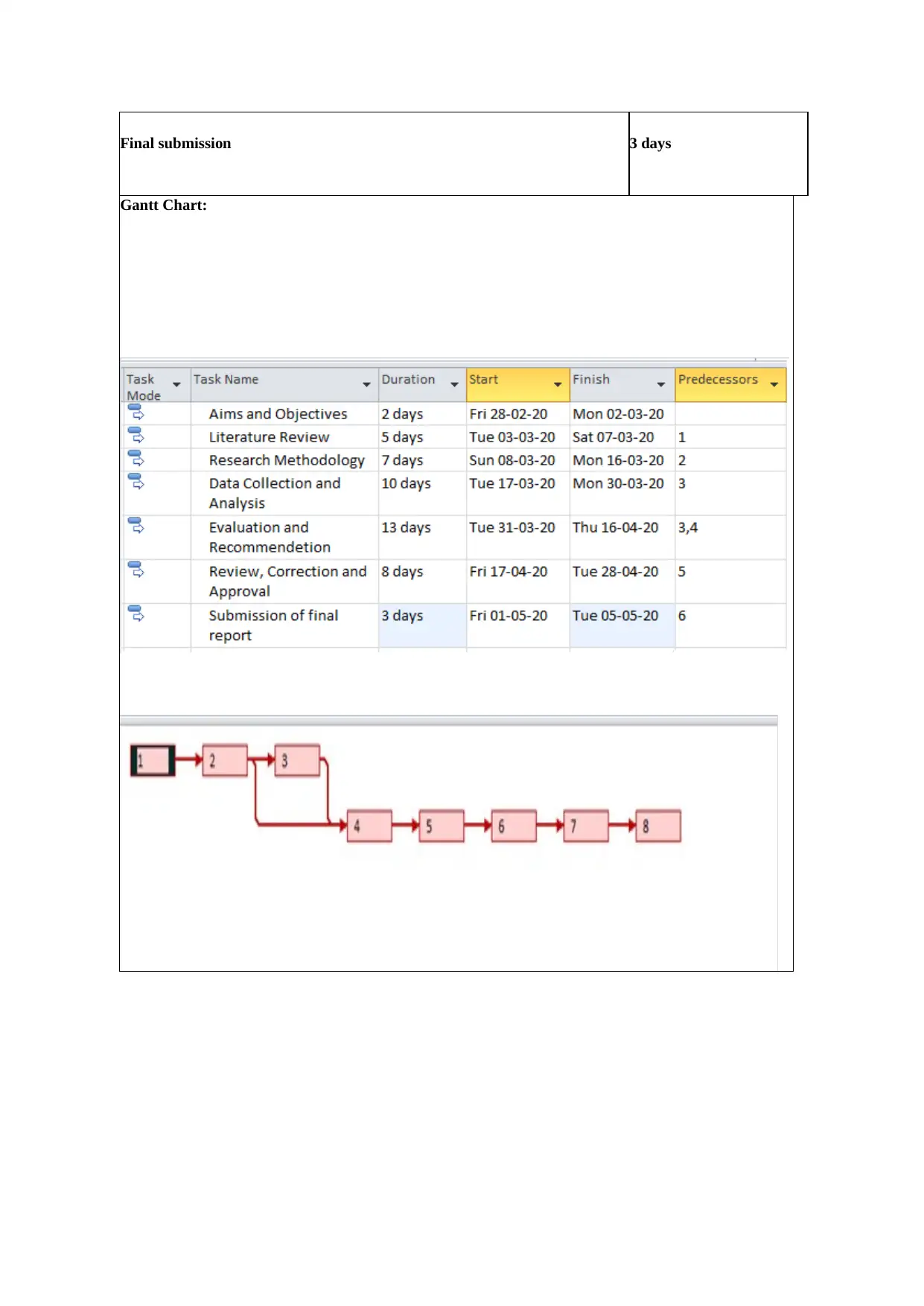
Final submission 3 days
Gantt Chart:
Gantt Chart:
⊘ This is a preview!⊘
Do you want full access?
Subscribe today to unlock all pages.

Trusted by 1+ million students worldwide
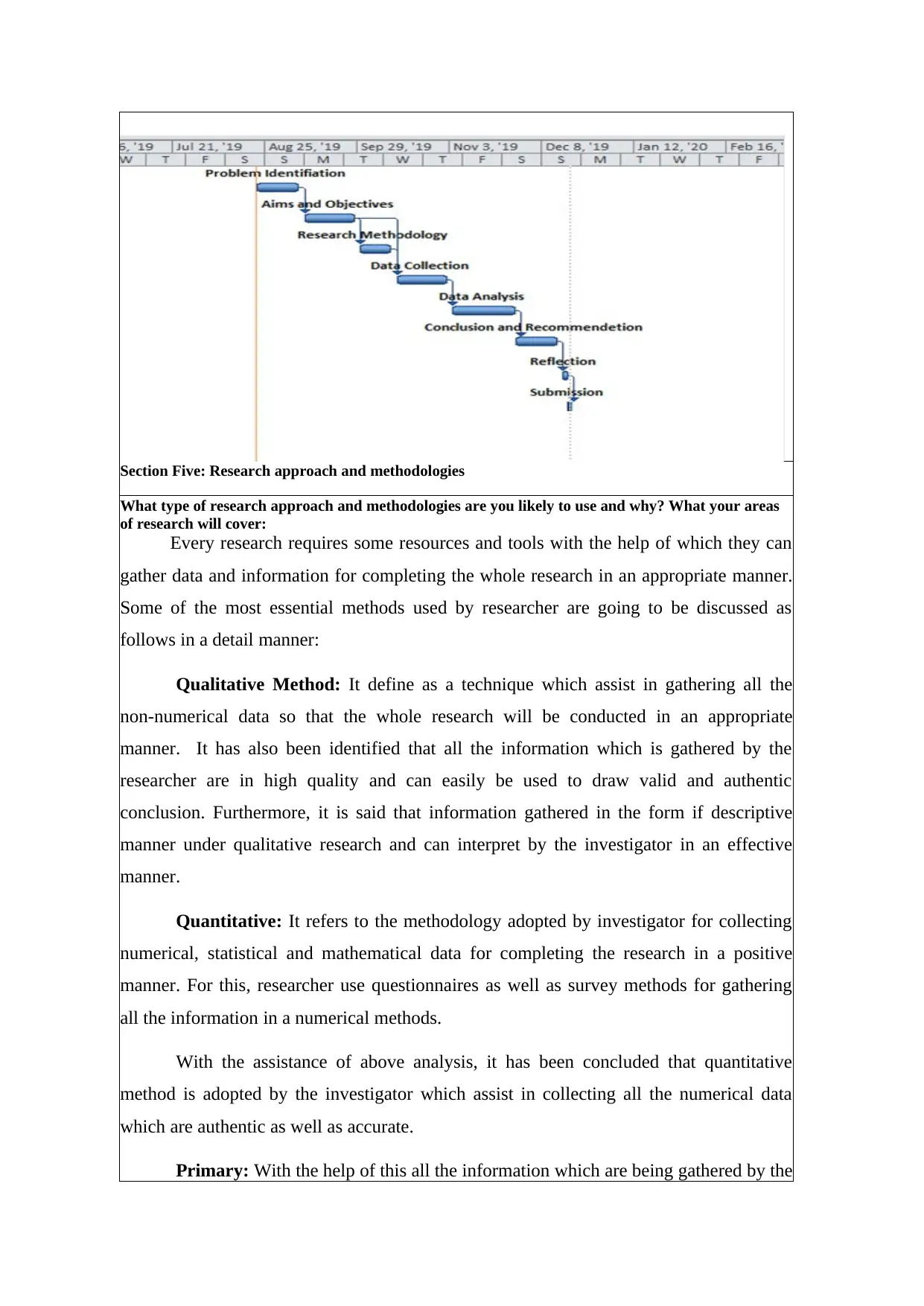
Section Five: Research approach and methodologies
What type of research approach and methodologies are you likely to use and why? What your areas
of research will cover:
Every research requires some resources and tools with the help of which they can
gather data and information for completing the whole research in an appropriate manner.
Some of the most essential methods used by researcher are going to be discussed as
follows in a detail manner:
Qualitative Method: It define as a technique which assist in gathering all the
non-numerical data so that the whole research will be conducted in an appropriate
manner. It has also been identified that all the information which is gathered by the
researcher are in high quality and can easily be used to draw valid and authentic
conclusion. Furthermore, it is said that information gathered in the form if descriptive
manner under qualitative research and can interpret by the investigator in an effective
manner.
Quantitative: It refers to the methodology adopted by investigator for collecting
numerical, statistical and mathematical data for completing the research in a positive
manner. For this, researcher use questionnaires as well as survey methods for gathering
all the information in a numerical methods.
With the assistance of above analysis, it has been concluded that quantitative
method is adopted by the investigator which assist in collecting all the numerical data
which are authentic as well as accurate.
Primary: With the help of this all the information which are being gathered by the
What type of research approach and methodologies are you likely to use and why? What your areas
of research will cover:
Every research requires some resources and tools with the help of which they can
gather data and information for completing the whole research in an appropriate manner.
Some of the most essential methods used by researcher are going to be discussed as
follows in a detail manner:
Qualitative Method: It define as a technique which assist in gathering all the
non-numerical data so that the whole research will be conducted in an appropriate
manner. It has also been identified that all the information which is gathered by the
researcher are in high quality and can easily be used to draw valid and authentic
conclusion. Furthermore, it is said that information gathered in the form if descriptive
manner under qualitative research and can interpret by the investigator in an effective
manner.
Quantitative: It refers to the methodology adopted by investigator for collecting
numerical, statistical and mathematical data for completing the research in a positive
manner. For this, researcher use questionnaires as well as survey methods for gathering
all the information in a numerical methods.
With the assistance of above analysis, it has been concluded that quantitative
method is adopted by the investigator which assist in collecting all the numerical data
which are authentic as well as accurate.
Primary: With the help of this all the information which are being gathered by the
Paraphrase This Document
Need a fresh take? Get an instant paraphrase of this document with our AI Paraphraser
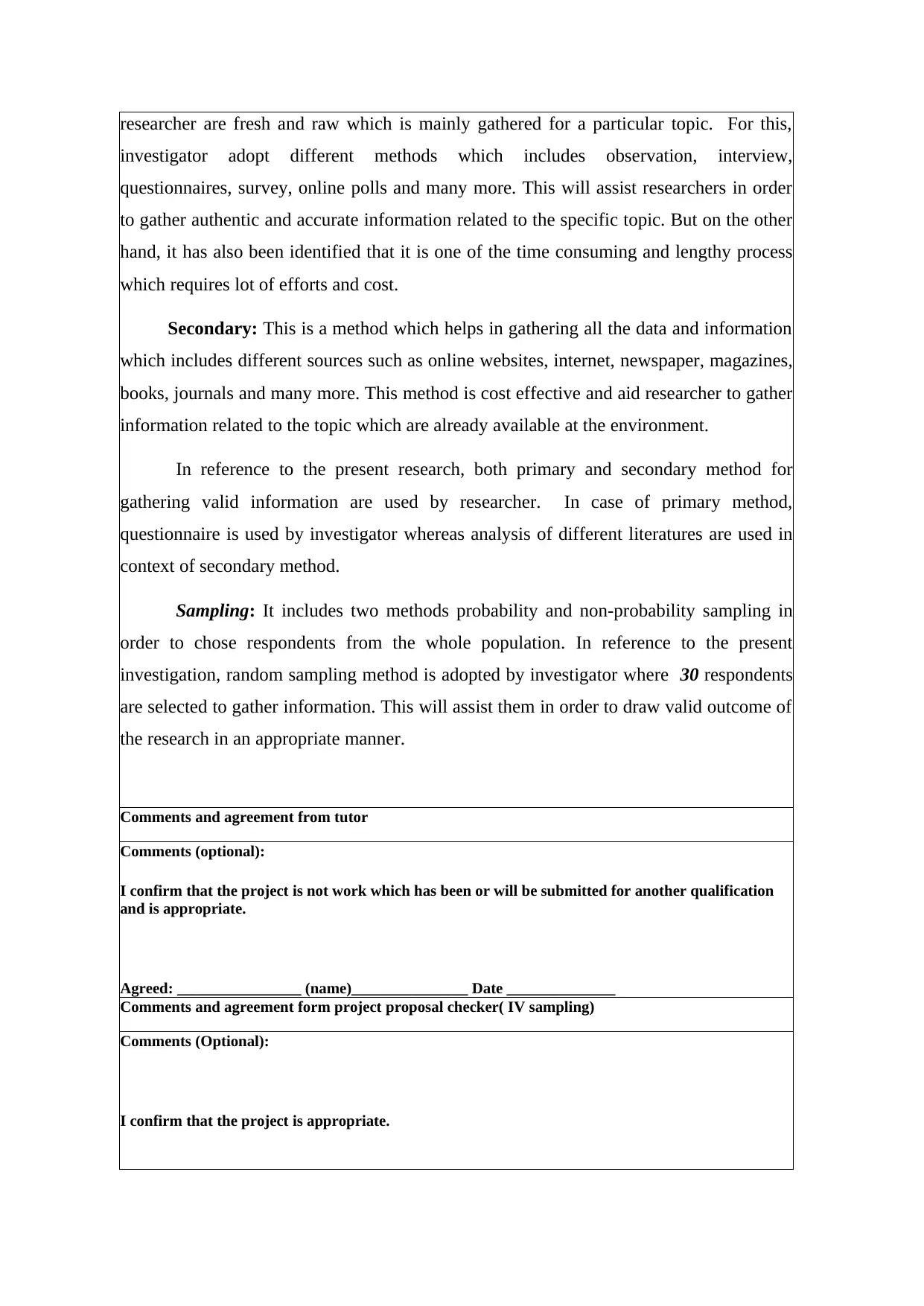
researcher are fresh and raw which is mainly gathered for a particular topic. For this,
investigator adopt different methods which includes observation, interview,
questionnaires, survey, online polls and many more. This will assist researchers in order
to gather authentic and accurate information related to the specific topic. But on the other
hand, it has also been identified that it is one of the time consuming and lengthy process
which requires lot of efforts and cost.
Secondary: This is a method which helps in gathering all the data and information
which includes different sources such as online websites, internet, newspaper, magazines,
books, journals and many more. This method is cost effective and aid researcher to gather
information related to the topic which are already available at the environment.
In reference to the present research, both primary and secondary method for
gathering valid information are used by researcher. In case of primary method,
questionnaire is used by investigator whereas analysis of different literatures are used in
context of secondary method.
Sampling: It includes two methods probability and non-probability sampling in
order to chose respondents from the whole population. In reference to the present
investigation, random sampling method is adopted by investigator where 30 respondents
are selected to gather information. This will assist them in order to draw valid outcome of
the research in an appropriate manner.
Comments and agreement from tutor
Comments (optional):
I confirm that the project is not work which has been or will be submitted for another qualification
and is appropriate.
Agreed: ________________ (name)_______________ Date ______________
Comments and agreement form project proposal checker( IV sampling)
Comments (Optional):
I confirm that the project is appropriate.
investigator adopt different methods which includes observation, interview,
questionnaires, survey, online polls and many more. This will assist researchers in order
to gather authentic and accurate information related to the specific topic. But on the other
hand, it has also been identified that it is one of the time consuming and lengthy process
which requires lot of efforts and cost.
Secondary: This is a method which helps in gathering all the data and information
which includes different sources such as online websites, internet, newspaper, magazines,
books, journals and many more. This method is cost effective and aid researcher to gather
information related to the topic which are already available at the environment.
In reference to the present research, both primary and secondary method for
gathering valid information are used by researcher. In case of primary method,
questionnaire is used by investigator whereas analysis of different literatures are used in
context of secondary method.
Sampling: It includes two methods probability and non-probability sampling in
order to chose respondents from the whole population. In reference to the present
investigation, random sampling method is adopted by investigator where 30 respondents
are selected to gather information. This will assist them in order to draw valid outcome of
the research in an appropriate manner.
Comments and agreement from tutor
Comments (optional):
I confirm that the project is not work which has been or will be submitted for another qualification
and is appropriate.
Agreed: ________________ (name)_______________ Date ______________
Comments and agreement form project proposal checker( IV sampling)
Comments (Optional):
I confirm that the project is appropriate.

Agreed /Disagree: (Name of the IV) Date
⊘ This is a preview!⊘
Do you want full access?
Subscribe today to unlock all pages.

Trusted by 1+ million students worldwide
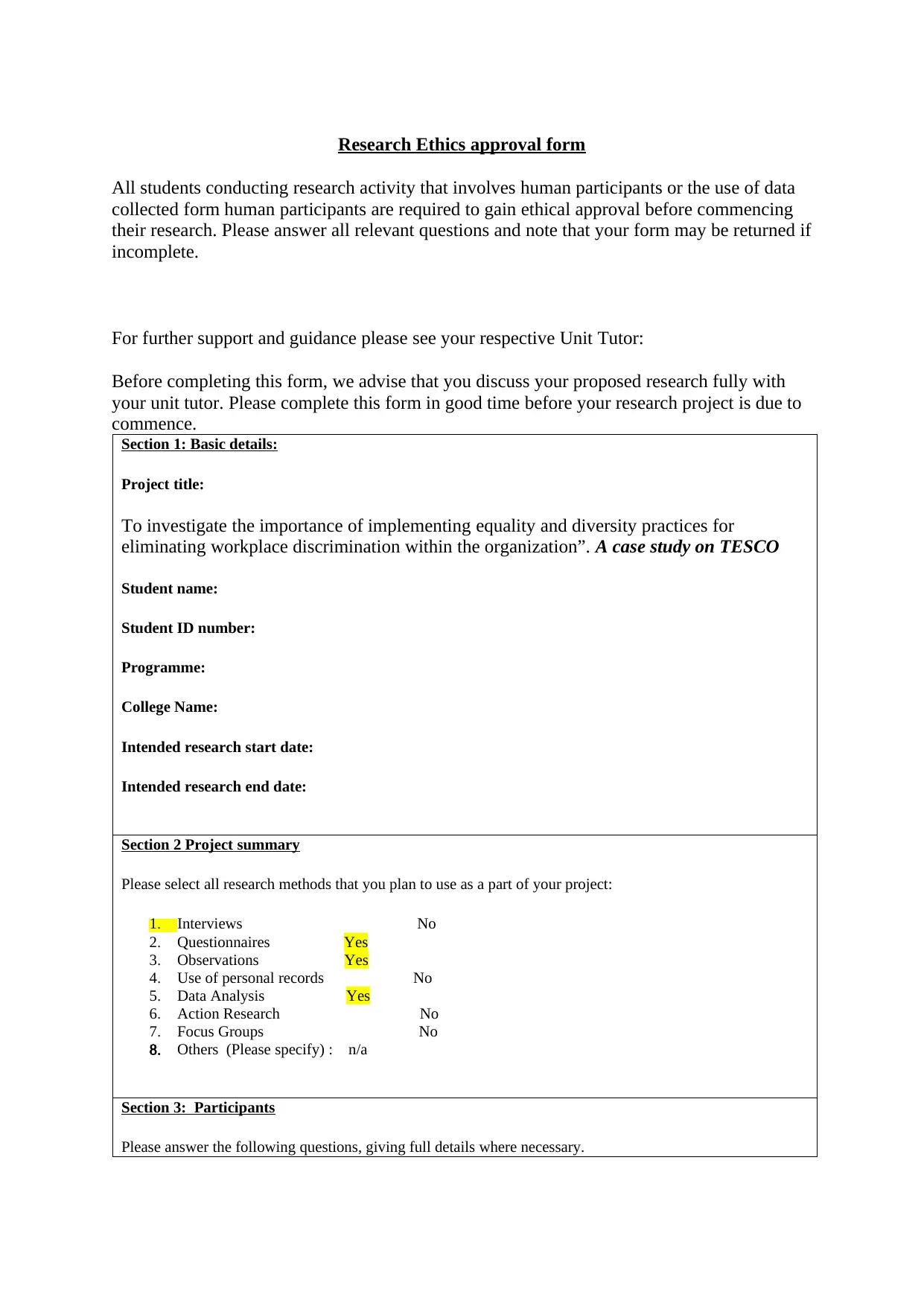
Research Ethics approval form
All students conducting research activity that involves human participants or the use of data
collected form human participants are required to gain ethical approval before commencing
their research. Please answer all relevant questions and note that your form may be returned if
incomplete.
For further support and guidance please see your respective Unit Tutor:
Before completing this form, we advise that you discuss your proposed research fully with
your unit tutor. Please complete this form in good time before your research project is due to
commence.
Section 1: Basic details:
Project title:
To investigate the importance of implementing equality and diversity practices for
eliminating workplace discrimination within the organization”. A case study on TESCO
Student name:
Student ID number:
Programme:
College Name:
Intended research start date:
Intended research end date:
Section 2 Project summary
Please select all research methods that you plan to use as a part of your project:
1. Interviews No
2. Questionnaires Yes
3. Observations Yes
4. Use of personal records No
5. Data Analysis Yes
6. Action Research No
7. Focus Groups No
8. Others (Please specify) : n/a
Section 3: Participants
Please answer the following questions, giving full details where necessary.
All students conducting research activity that involves human participants or the use of data
collected form human participants are required to gain ethical approval before commencing
their research. Please answer all relevant questions and note that your form may be returned if
incomplete.
For further support and guidance please see your respective Unit Tutor:
Before completing this form, we advise that you discuss your proposed research fully with
your unit tutor. Please complete this form in good time before your research project is due to
commence.
Section 1: Basic details:
Project title:
To investigate the importance of implementing equality and diversity practices for
eliminating workplace discrimination within the organization”. A case study on TESCO
Student name:
Student ID number:
Programme:
College Name:
Intended research start date:
Intended research end date:
Section 2 Project summary
Please select all research methods that you plan to use as a part of your project:
1. Interviews No
2. Questionnaires Yes
3. Observations Yes
4. Use of personal records No
5. Data Analysis Yes
6. Action Research No
7. Focus Groups No
8. Others (Please specify) : n/a
Section 3: Participants
Please answer the following questions, giving full details where necessary.
Paraphrase This Document
Need a fresh take? Get an instant paraphrase of this document with our AI Paraphraser
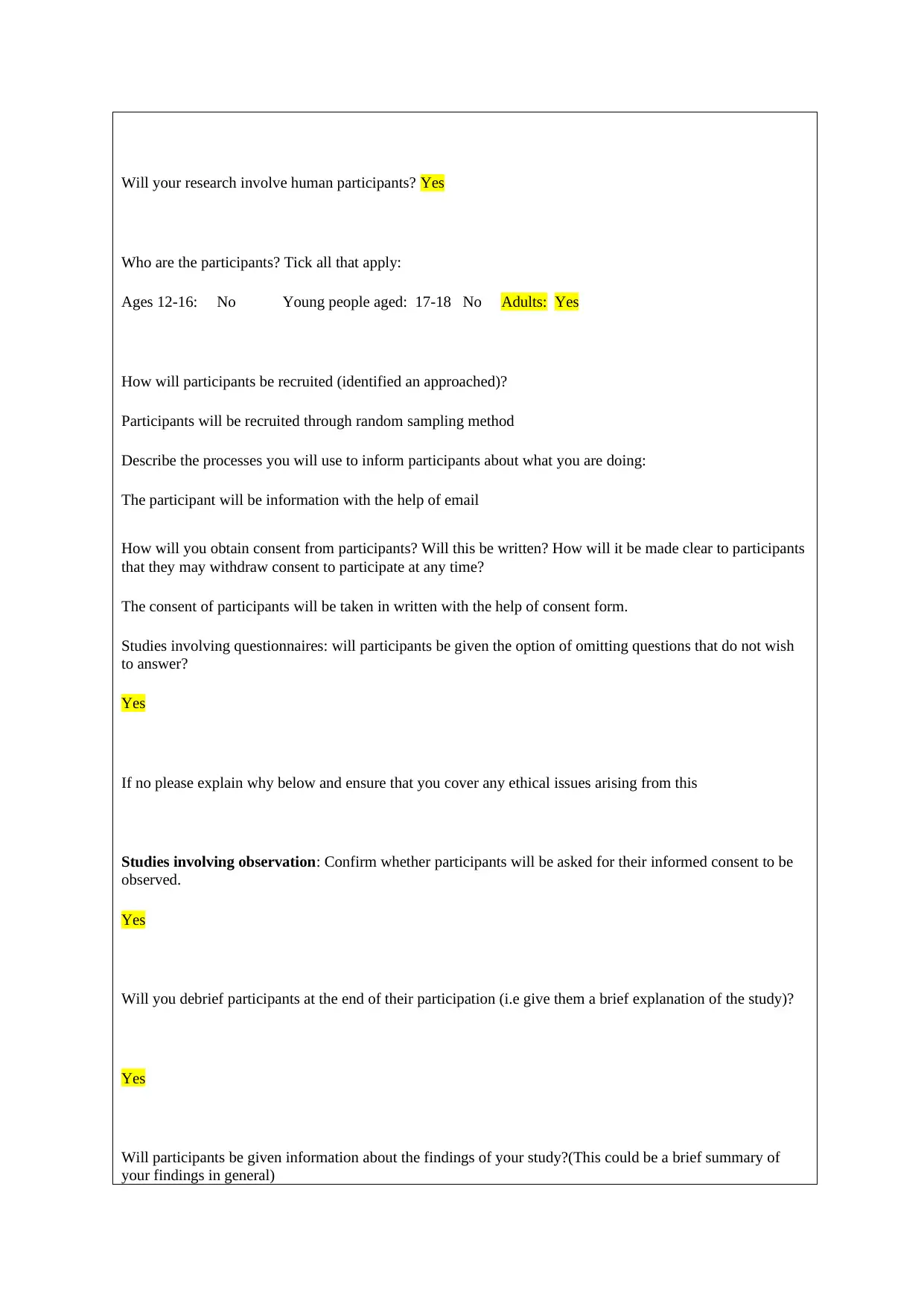
Will your research involve human participants? Yes
Who are the participants? Tick all that apply:
Ages 12-16: No Young people aged: 17-18 No Adults: Yes
How will participants be recruited (identified an approached)?
Participants will be recruited through random sampling method
Describe the processes you will use to inform participants about what you are doing:
The participant will be information with the help of email
How will you obtain consent from participants? Will this be written? How will it be made clear to participants
that they may withdraw consent to participate at any time?
The consent of participants will be taken in written with the help of consent form.
Studies involving questionnaires: will participants be given the option of omitting questions that do not wish
to answer?
Yes
If no please explain why below and ensure that you cover any ethical issues arising from this
Studies involving observation: Confirm whether participants will be asked for their informed consent to be
observed.
Yes
Will you debrief participants at the end of their participation (i.e give them a brief explanation of the study)?
Yes
Will participants be given information about the findings of your study?(This could be a brief summary of
your findings in general)
Who are the participants? Tick all that apply:
Ages 12-16: No Young people aged: 17-18 No Adults: Yes
How will participants be recruited (identified an approached)?
Participants will be recruited through random sampling method
Describe the processes you will use to inform participants about what you are doing:
The participant will be information with the help of email
How will you obtain consent from participants? Will this be written? How will it be made clear to participants
that they may withdraw consent to participate at any time?
The consent of participants will be taken in written with the help of consent form.
Studies involving questionnaires: will participants be given the option of omitting questions that do not wish
to answer?
Yes
If no please explain why below and ensure that you cover any ethical issues arising from this
Studies involving observation: Confirm whether participants will be asked for their informed consent to be
observed.
Yes
Will you debrief participants at the end of their participation (i.e give them a brief explanation of the study)?
Yes
Will participants be given information about the findings of your study?(This could be a brief summary of
your findings in general)
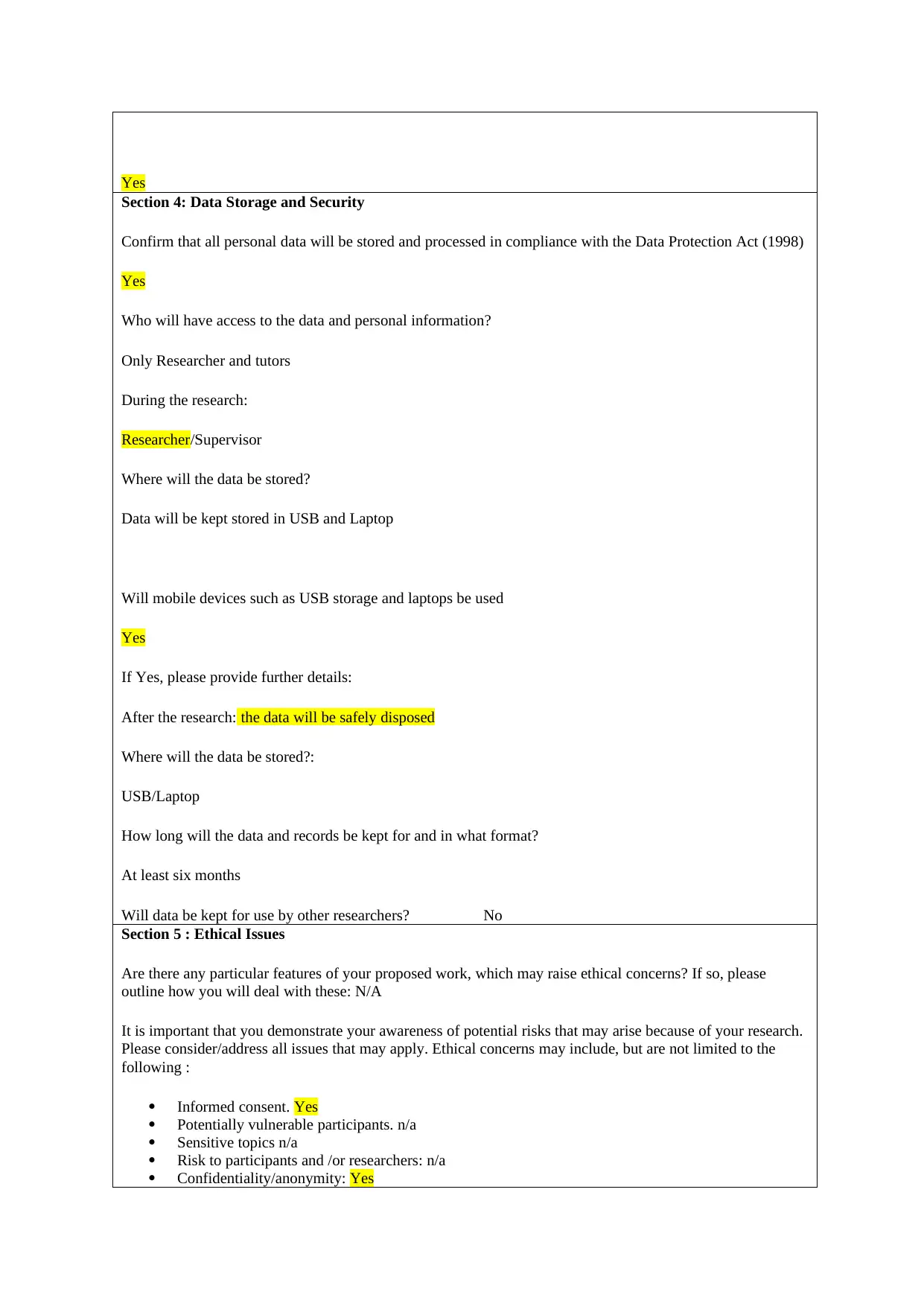
Yes
Section 4: Data Storage and Security
Confirm that all personal data will be stored and processed in compliance with the Data Protection Act (1998)
Yes
Who will have access to the data and personal information?
Only Researcher and tutors
During the research:
Researcher/Supervisor
Where will the data be stored?
Data will be kept stored in USB and Laptop
Will mobile devices such as USB storage and laptops be used
Yes
If Yes, please provide further details:
After the research: the data will be safely disposed
Where will the data be stored?:
USB/Laptop
How long will the data and records be kept for and in what format?
At least six months
Will data be kept for use by other researchers? No
Section 5 : Ethical Issues
Are there any particular features of your proposed work, which may raise ethical concerns? If so, please
outline how you will deal with these: N/A
It is important that you demonstrate your awareness of potential risks that may arise because of your research.
Please consider/address all issues that may apply. Ethical concerns may include, but are not limited to the
following :
Informed consent. Yes
Potentially vulnerable participants. n/a
Sensitive topics n/a
Risk to participants and /or researchers: n/a
Confidentiality/anonymity: Yes
Section 4: Data Storage and Security
Confirm that all personal data will be stored and processed in compliance with the Data Protection Act (1998)
Yes
Who will have access to the data and personal information?
Only Researcher and tutors
During the research:
Researcher/Supervisor
Where will the data be stored?
Data will be kept stored in USB and Laptop
Will mobile devices such as USB storage and laptops be used
Yes
If Yes, please provide further details:
After the research: the data will be safely disposed
Where will the data be stored?:
USB/Laptop
How long will the data and records be kept for and in what format?
At least six months
Will data be kept for use by other researchers? No
Section 5 : Ethical Issues
Are there any particular features of your proposed work, which may raise ethical concerns? If so, please
outline how you will deal with these: N/A
It is important that you demonstrate your awareness of potential risks that may arise because of your research.
Please consider/address all issues that may apply. Ethical concerns may include, but are not limited to the
following :
Informed consent. Yes
Potentially vulnerable participants. n/a
Sensitive topics n/a
Risk to participants and /or researchers: n/a
Confidentiality/anonymity: Yes
⊘ This is a preview!⊘
Do you want full access?
Subscribe today to unlock all pages.

Trusted by 1+ million students worldwide
1 out of 13
Related Documents
Your All-in-One AI-Powered Toolkit for Academic Success.
+13062052269
info@desklib.com
Available 24*7 on WhatsApp / Email
![[object Object]](/_next/static/media/star-bottom.7253800d.svg)
Unlock your academic potential
Copyright © 2020–2025 A2Z Services. All Rights Reserved. Developed and managed by ZUCOL.





